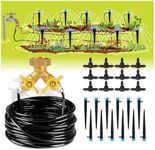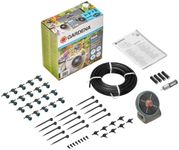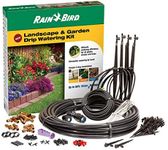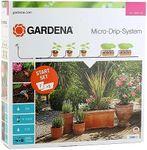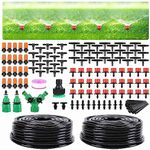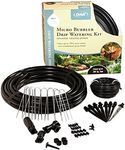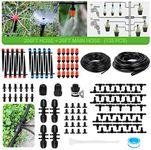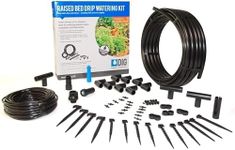Buying Guide for the Best Drip Irrigation Kits
Choosing the right drip irrigation kit can make watering your garden or plants much more efficient and convenient. Drip irrigation delivers water directly to the roots, reducing waste and promoting healthier growth. When selecting a kit, it's important to consider the size of your area, the types of plants you have, and how much control you want over the watering process. Understanding the key features will help you pick a kit that matches your needs and ensures your plants thrive.Coverage AreaCoverage area refers to the maximum space that the kit can effectively water. This is important because you want to make sure the kit can reach all your plants without leaving any dry spots. Kits are usually rated for small (up to 50 square meters), medium (50-150 square meters), or large areas (over 150 square meters). If you have a small garden or a few pots, a kit with a smaller coverage area will be sufficient. For larger vegetable beds or multiple rows of plants, look for a kit designed for bigger spaces.
Number and Type of EmittersEmitters are the parts that release water to your plants. The number and type of emitters determine how many plants you can water and how the water is delivered. There are drippers for slow, steady watering, and sprayers or micro-sprinklers for broader coverage. Kits with more emitters are better for gardens with many plants, while fewer emitters work for smaller setups. Consider the types of plants you have—delicate flowers may need gentle drippers, while larger shrubs might benefit from sprayers.
Tubing Length and DiameterTubing carries water from the source to your plants. The length and diameter of the tubing affect how far and how much water can be delivered. Shorter, thinner tubes are suitable for compact gardens or balcony setups, while longer, wider tubes are needed for larger or more spread-out gardens. Measure your garden and plan the layout before choosing, ensuring the kit includes enough tubing to reach all your plants without losing water pressure.
Water Flow ControlWater flow control allows you to adjust how much water each plant receives. Some kits have adjustable emitters or valves, while others have fixed flow rates. Adjustable systems are useful if you have a variety of plants with different watering needs, as you can fine-tune the amount for each one. If your plants have similar needs, a fixed-flow system may be simpler and easier to manage.
Ease of InstallationEase of installation refers to how simple it is to set up the kit. Some kits are designed for quick, tool-free assembly, while others may require more effort and basic tools. If you’re new to drip irrigation or want a hassle-free experience, look for kits labeled as easy to install or beginner-friendly. More advanced kits may offer greater customization but can take longer to set up.
ExpandabilityExpandability means whether you can add more tubing or emitters to the kit in the future. This is important if you plan to grow your garden or add more plants later. Some kits are modular and allow for easy expansion, while others are limited to their original size. If you think your watering needs might change, choose a kit that can grow with you.
Compatibility with Timers and FiltersSome drip irrigation kits can be connected to automatic timers or water filters. Timers help automate watering, making it easier to maintain a consistent schedule, while filters prevent clogging from debris. If you want a low-maintenance system or have hard water, look for kits that are compatible with these accessories. This can save you time and keep your system running smoothly.
